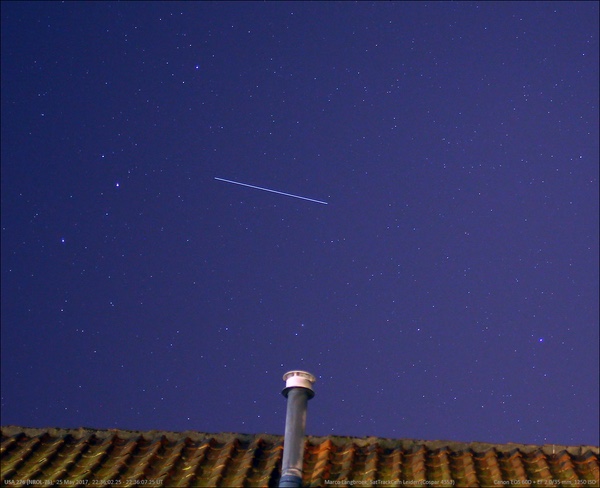Close encounters of the classified kindOn June 3, 2017, a mysterious US spy satellite did a close flyby of the International Space Stationby Marco Langbroek
|
| Specific satellite types tend to target specific orbital inclinations. A 50-degree inclination didn’t match anything we know. |
There was also another spacecraft sneaking up for a close approach, one that was classified and not supposed to be noticed. On June 3, the US military satellite USA 276 approached the ISS to a nominal distance of 6.4 kilometers and effectively circled the ISS in both the cross-track and along-track directions.
A mystery satellite in an odd orbit
On May 1, at 7:15 am EDT (1115 GMT), SpaceX launched a Falcon 9 rocket with a classified payload from Kennedy Space Center’s Launch Complex 39A in Florida. The launch was designated NROL-76, and it carried a payload into low Earth obit for the National Reconnaissance Office (NRO). The launch had been postponed twice: first from April 16 to April 30, and then (due to a sensor issue on the Falcon 9 booster) to May 1.
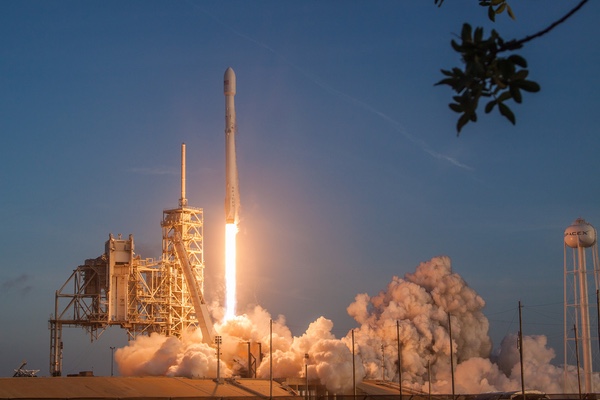 The May 1 launch of USA 276 on a SpaceX Falcon 9, on a mission designated NROL-76. (credit: SpaceX) |
Little was known about the payload itself, designated USA 276: its purpose was not made public. All we know is that it was built by Ball Aerospace as part of a “delivery in orbit” contract. Ball Aerospace is a company that previously was involved in the development of optical remote sensing satellites. It also works on an autonomous satellite rendezvous and servicing mission.
This launch was peculiar right away. Even before launch, the launch azimuth gleaned from Maritime Broadcast Warnings suggested a launch into a 50 to 51 degree inclined orbit. The indicated de-orbit zone for the Falcon 9 upper stage south of Madagascar indicated the same.
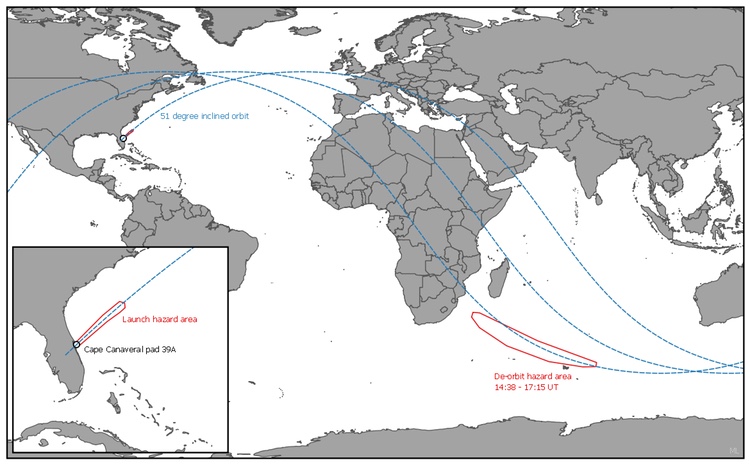 Pre-launch 51-degree low Earth orbit estimate from launch and de-orbit hazard areas (map by author). |
A 50-degree orbital inclination is unusual. Specific satellite types tend to target specific orbital inclinations: optical reconnaissance satellites like the KH-11 ADVANCED CRYSTAL (Keyhole/KENNEN), for example, go into sun-synchronous polar orbits inclined at 98 degrees. SIGINT satellites in low Earth orbit (LEO) like the INTRUDER (NOSS), and SIGINT and communications satellites in highly elliptical orbits (HEO), target a 63.4-degree orbital inclination. Radar satellites typically target a 68- or 57-degree orbital inclination, such as ONYX (Lacrosse), or its 123-degree retrograde equivalent, like TOPAZ (FIA). The X-37B robotic spaceplane has, so far, been launched into 38-degree inclined orbits. And launches towards geostationary altitudes from the Cape are typically first aiming for a 28 degree inclined parking orbit. A 50-degree inclination didn’t match anything we know.
Because there was no precedent for a 50-degree inclined orbit, attempts by independent observers to make initial estimates of the other orbital parameters for this launch were difficult. Orbital altitudes could only be guessed. A number of analysts didn’t want to believe a 50-degree inclination anyway, arguing for a dogleg maneuver into a 63.4-degree HEO orbit.
| Initial estimates for this approach suggested that USA 276 would pass within 20 kilometers of the ISS in the afternoon of June 3. It would later transpire that it actually came even closer. |
It took three weeks for the payload to be discovered in orbit, and when that happened the 50-degree orbital inclination was confirmed. Leo Barhorst from the Netherlands, a member of a small dedicated group of amateur trackers specializing in classified satellites, first found the payload in the early morning of May 24. The object was in a 50-degree inclined orbit with perigee at 388 kilometers and apogee at 408 kilometers.
This is lower than most military payloads and very similar to the orbital altitude of the ISS (402 by 408 kilometers), but with a small, 1.6-degree difference in orbital inclination. Notwithstanding the latter, the two orbits are peculiarly similar, the more so since the values for the RAAN (the position of the node, where the orbit crosses the equator) of both objects were close to each other as well at the time of discovery. Behind the scenes in amateur tracking circles, this elicited a lot of discussion.
Close encounters
On May 25, this author first drew attention to the fact that USA 276, if it did not change its orbit, would physically pass close to the ISS around June 3–4. Initial estimates for this approach (or rather a series of approaches), based on a NASA-prognosed orbit for the ISS and a periodically updated orbit for USA 276 from amateur observations, suggested that USA 276 would pass within 20 kilometers of the ISS in the afternoon of June 3. It would later transpire that it actually came even closer.
And if that in itself wasn’t already peculiar enough, the Dragon was originally scheduled to arrive at the ISS around the same date. On June 4 near 13:30 GMT, when Dragon was originally to have been grappled and berthed to the ISS, USA 276 would be some 1,000 kilometers in front of the ISS, close enough to have a good view of the grappling and berthing but far enough to not be a danger to the approaching, maneuvering spacecraft. Was this coincidence?
As things actually transpired, the Dragon CRS-11 launch was postponed by two days, and it arrived at the ISS on June 5, a day late, in what seems to be an accelerated schedule compared to the original three-day plan. Still, even with this delay, USA 276 would have had direct view of the grappling and berthing, from a distance of about 2,000 kilometers.
Moreover, in a surprise move, the Cygnus was undocked from the ISS on June 4 around 7:05 am EDT (1105 GMT), the date that Dragon would originally have arrived. This sudden departure was one month in advance of the originally scheduled undocking date. USA 276 would have had a view of the undocking from a distance of about 900 kilometers. The official explanation by NASA for the earlier release was that the postponement of Dragon’s arrival had “opened up” astronaut time to do so.
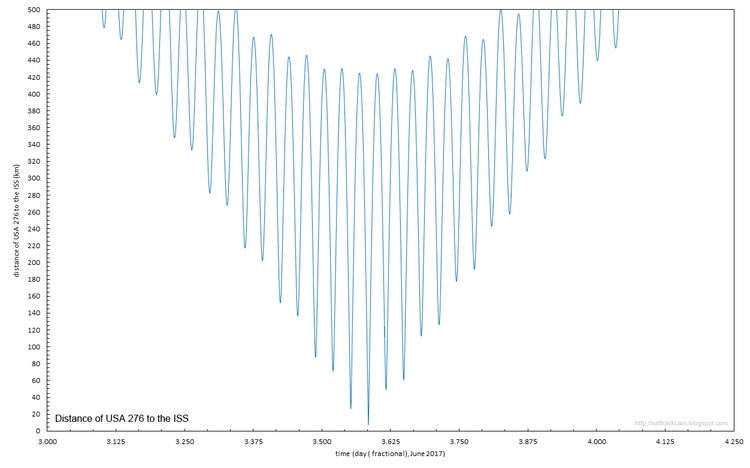 Variation of distance of USA 276 to the ISS around close approach, June 3, 2017 |
List of close approach moments to distances smaller than 500 kilometers
DATE TIME (UT) DISTANCE (km)
3 Jun 2017 02:28:52 478.5
3 Jun 2017 03:13:37 464.4
3 Jun 2017 04:01:17 413.2
3 Jun 2017 04:46:14 398.9
3 Jun 2017 05:33:41 347.8
3 Jun 2017 06:18:50 333.3
3 Jun 2017 07:06:04 282.4
3 Jun 2017 07:51:26 267.7
3 Jun 2017 08:38:28 217.1
3 Jun 2017 09:24:03 202.2
3 Jun 2017 10:10:52 151.9
3 Jun 2017 10:56:39 136.6
3 Jun 2017 11:43:15 87.1
3 Jun 2017 12:29:16 71.0
3 Jun 2017 13:15:38 26.3
3 Jun 2017 14:01:52 6.4
3 Jun 2017 14:48:01 48.8
3 Jun 2017 15:34:28 60.5
3 Jun 2017 16:20:24 112.5
3 Jun 2017 17:07:05 126.1
3 Jun 2017 17:52:46 177.5
3 Jun 2017 18:39:41 191.7
3 Jun 2017 19:25:09 242.9
3 Jun 2017 20:12:18 257.4
3 Jun 2017 20:57:31 308.3
3 Jun 2017 21:44:54 323.1
3 Jun 2017 22:29:53 373.7
3 Jun 2017 23:17:30 388.8
4 Jun 2017 00:02:15 439.2
4 Jun 2017 00:50:07 454.5
The ISS flyby
The actual ISS flyby on June 3, a day before the sudden undocking of Cygnus, was even closer than originally anticipated. A post-analysis using an actual tracking-based ISS orbit and a USA 276 orbit based on observations that span the close approach window, shows that near 14:01:52 GMT on June 3, USA 276 approached the ISS to about 6.4 ± 2 kilometers (the two-kilometer uncertainty derives from the approximately one-kilometer positional uncertainty inherent in TLE-style orbital elements). This approach happened close to the apogee of both object’s orbits, over the southern Atlantic Ocean north of the Falklands, near 43°.75 S, 45°.45 W.
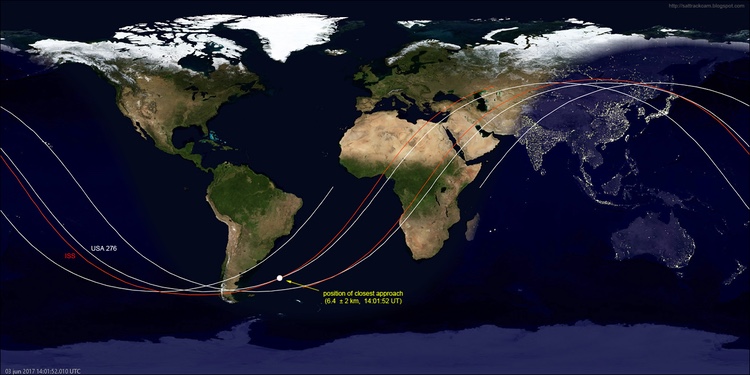 Position of the point of closest approach on June 3 (map by author) |
A close approach of 6.4 ± 2 kilometers is very close. The approach remained just, but only just, on the safe side. A safety box of 10 by 4 by 4 kilometers is in effect around the ISS: any object coming within this box warrants a discussion whether the ISS should conduct an avoidance maneuver. USA 276 stayed just outside of this box, by about 1 kilometer.
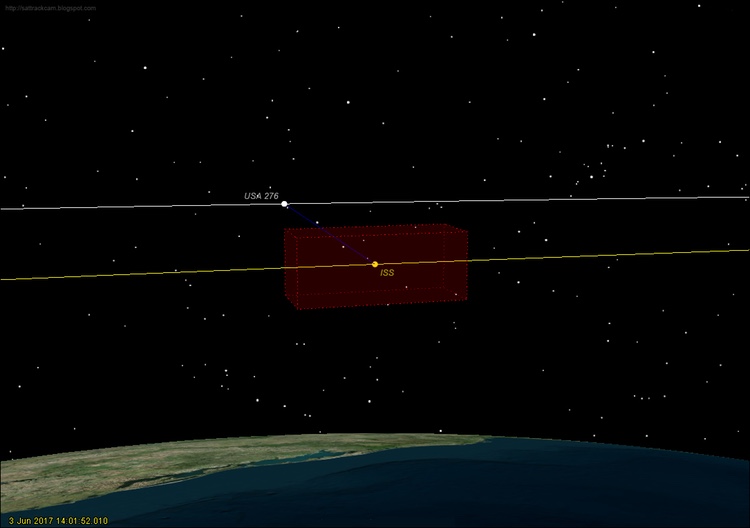 Situation of closest approach on 3 June 2017 14:01:52 UT in 3D. The red box is the ISS safety box |
The orbital geometry—an inclination difference of 1.6 degrees, perigee somewhat below that of the ISS orbit, and apogee altitude similar to that of the ISS orbit and near the same orbital position—had an interesting effect. The resulting positional difference with respect to the ISS over time is such that it makes USA 276 in effect “circle” the ISS, in an elongated ellipse in the cross-track direction (perpendicular to the ISS direction of movement) as well as in the along-track direction. This can be seen in the Clohesy-Wiltshire diagrams below, which plot the position of USA 276 relative to the ISS near close approach in cross-track and along-track direction:
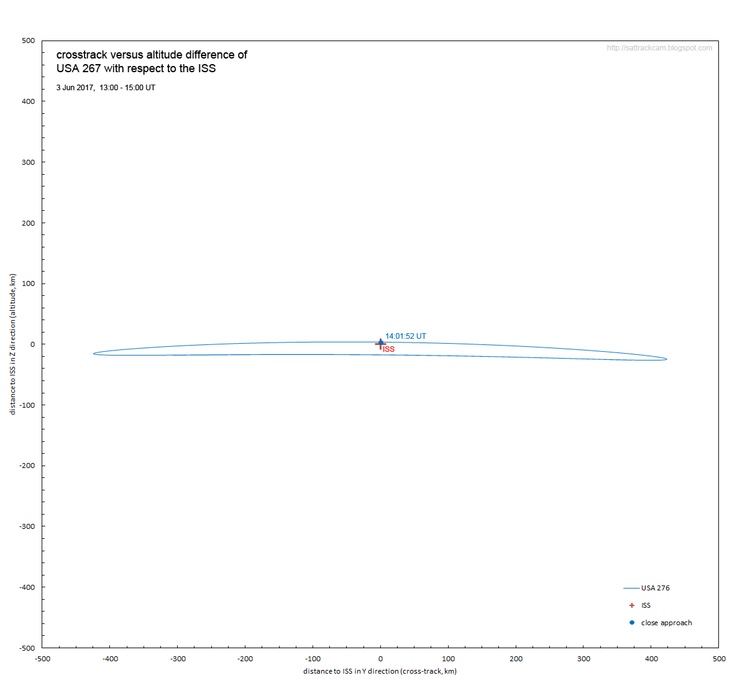 |
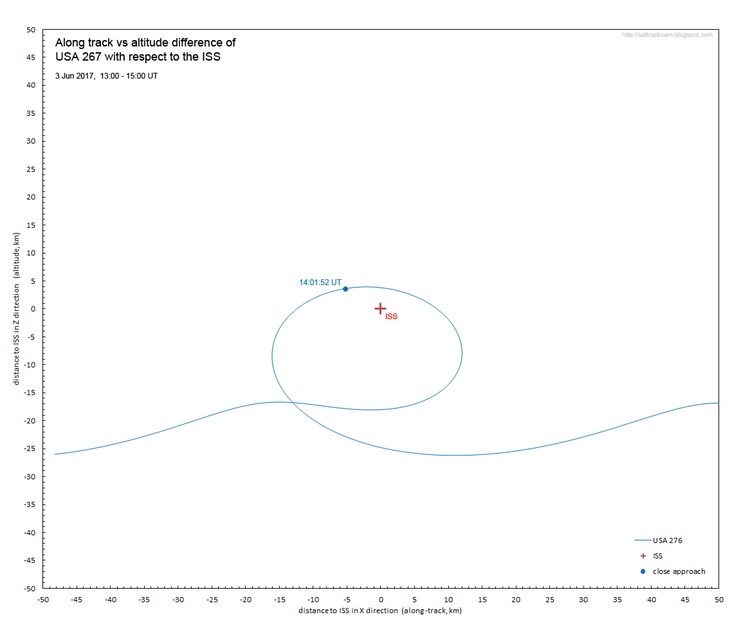 |
Note that this apparent “circling” is purely an effect of the relative geometry of both orbits. To be clear and avoid misunderstandings: USA 276 was not actively maneuvering around the ISS to accomplish this.
Coincidence or not?
Was this all, the close approach and coincidence in time with cargo ship arrivals and departures, a chain of coincidences or not? Opinions are divided, and many analysts (including the author) remain on the fence, although I am more and more inclined to think it was intentional.
Let us first explore some motivations why it could be intentional, i.e.: what could have been the purpose, if this was intentional?
| The close approach and circling effectively allowed the spacecraft to make a detailed 3-D scan of the target (ISS in this case), for example in order to record all surface details like external grappling arms and docking ports. |
In the most likely scenario for this to be the case, USA 276 could be a technology demonstrator of a spacecraft intended to monitor close approaches and berthings in space in detail. Monitoring approaches and berthings to the ISS could be done as a proof-of-concept. As a test object, the ISS would be ideal: frequent cargo and crew spacecraft approaches that go about in a predictable manner and are well documented. A bonus is that you do not have to develop, finance, and launch the test target objects; only the observing spacecraft itself.
From this notion we can conjecture about the scenario that we saw play out on June 3–4, which involved USA 276 approaching the ISS closely on June 3 while effectively “circling” it, and next observing the unberthing of Cygnus OA-7 and berthing of Dragon CRS-11 from a safe distance on June 4 and 5. The close approach and circling effectively allowed the spacecraft to make a detailed 3-D scan of the target (ISS in this case), for example in order to record all surface details like external grappling arms and docking ports. It next monitored the actual grappling and berthing or unberthing from a somewhat greater, and safe, distance.
While conjecture, this scenario does make sense. There is certainly an interest in such a monitoring capability within the US military. As previously reported on in The Space Review by Brian Weeden, both China and Russia have been experimenting with close approaches and (temporary) grappling/berthing objects in LEO over the last decade (see “Dancing in the dark: The orbital rendezvous of SJ-12 and SJ-06F”, The Space Review, August 30, 2010, and “Dancing in the dark redux: Recent Russian rendezvous and proximity operations in space”, The Space Review, October 5, 2015). This has elicited worry within the US military, where the concern is that such techniques could be used in an anti-satellite role, for example in order to capture and/or disable critical US military space assets.
The US military itself has previously experimented with spacecraft for close inspection of other spacecraft at geostationary altitudes, including Prowler (launched in 1990 on STS-38), the two MiTEx spacecraft, and, most recently, the Geosynchronous Space Situational Awareness Program spacecraft. The development and proof-of-concept testing of a LEO variant of such a close-distance monitoring spacecraft would not be a stretch of the imagination.
Additional arguments
There are additional arguments to think the approach was intentional. First, there is the odd orbit of USA 276 itself. The orbital inclination is unusual (so why pick it?) and the similarity of the orbit to that of the ISS is immediately obvious. I am therefore not willing to believe that the NRO was not aware of potential close approaches to the ISS. From a space situational awareness angle, they certainly would have investigated and monitored that possibility.
The ISS is not just a spacecraft. First of all, it is crewed, so there is a potential risk to human lives, including the US astronauts on board. It is also a high-profile object, being the poster child for international peaceful cooperation in space and a truly international political endeavor. Several countries participate in the ISS: besides the US, it includes Russia, members of the European Space Agency, Japan, and Canada. This includes countries, notably Russia, with sensitive geopolitical relations with the US. This makes a secret close approach of a US military satellite to the ISS very sensitive and politically charged. I tend to think that the NRO would therefore not let that happen without clear reasons. If they did allow it on a whim, that would seem terribly negligent and unnecessarily risky (also in a political sense.)
| There are also arguments against an intentional close approach. The strongest of these is that the launch window of USA 276 was of two hours duration and seems to have been a fixed window independent of date. |
From amateur observations, we have some indications of small maneuvers around the close approach date, starting May 31 and continuing to June 5. These notably seemed to be done to temporarily halt and stabilize the drift of the argument of perigee of the orbit near 110 degrees—i.e., to stabilize the position of perigee and apogee such that the apogee of USA 276 (the highest point in its slightly elliptical orbit) is close to the apogee of the ISS and close to the point where the orbits of USA 276 and the ISS intersect. ISS and USA 276 have similar apogees, so with the right mean anomaly for USA 276 this ensures that both spacecraft will come very close near this point. A few days after the approach, by June 11, the argument of perigee had been allowed to drift again (we have no observations between June 5 and June 11.)
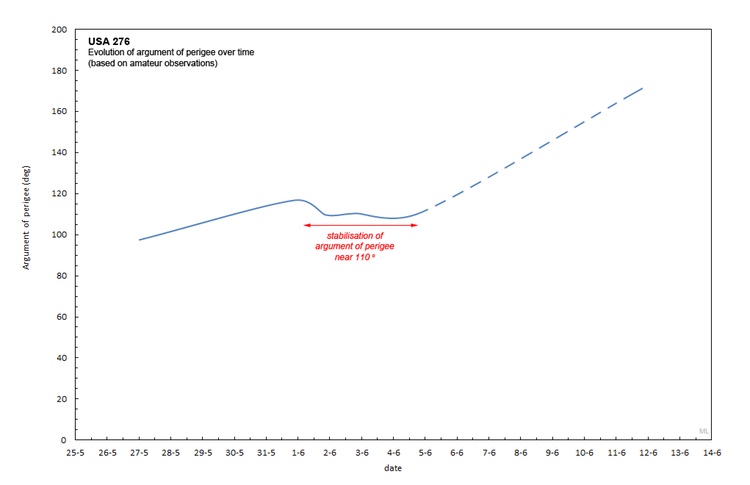 Evolution of the argument of perigee (AOP) of the USA 276 orbit over time, based on amateur observations. Between May 31 and June 5, there is an apparent temporary stabilization of the drift in AOP near a value of 110°. |
This maneuvering, seemingly aiming to stabilize the argument of perigee such that apogee stays close to the point of orbit intersection, is a strong argument that the approach was, in fact, intentionally engineered.
Arguments against
There are also arguments against an intentional close approach. The strongest of these is that the launch window of USA 276 was of two hours duration and seems to have been a fixed window independent of date. When targeting the orbital plane of the ISS, the launch window is very small (almost instantaneous), and shifts by approximately 24 minutes each day. But the launch was postponed twice, first from April 16 to April 30 and then again to May 1, and we know that the intended launch time was the same on each of these dates: 1115 GMT. This while in order to target the ISS orbital plane on April 16, the launch time would have had to be six hours earlier. As Ted Molczan has pointed out, with a launch at 1115 GMT on April 16 and similar target inclination and orbital altitudes, it would have taken four years of orbital precession before the orbital planes of USA 276 and ISS would come as close as it did with the May 1 launch.
But this argument has its own problems. What the fixed launch time would suggest is that the exact orbital plane being launched into (in terms of location of the node at launch) was not critical. But that in itself then begs the question why the NRO allowed a launch to happen that would bring it so close to the ISS so soon after launch. When the launch-time is not critical, the NRO could have avoided this quite simply by picking another launch time. Hence, the argument of the fixed launch window is one that seems to bite its own tail. It should be noted in this context that the orbit of USA 276 is not sun-synchronous, so a constant solar illumination angle clearly wasn’t a consideration for sticking to this launch time.
There has been speculation whether the launch postponements were perhaps a ruse to make it look like the alignment with the orbital plane of the ISS was coincidental. This is dangerously speculative, but it is also not entirely without precedent: there have been suspicious “holds” during earlier classified launches which clearly targeted a specified orbital plane. In those cases, however, it concerned brief launch postponement within an ostensibly several-hour launch window, not postponements of half a month.
Another point that might argue against the flyby being intentional, is that this was an NRO mission. Space situational awareness monitoring missions are not the normal realm of the NRO, but rather of the Air Force. The NRO’s focus is, as the name of the organization indicates, on reconnaissance. But maybe—and this is again highly speculative—it signals a shift in perception within the NRO to include a wider definition of the term “reconnaissance”: monitoring other spacecraft can be argued to be a form of reconnaissance too, one that reflects the rising importance of space in modern warfare.
Grab your tinfoil hats
The curious case of USA 276 is complicated by the sheer number of “coincidences” that appear to be involved. It is very easy (and dangerous) to descend into conspiracy theory and see everything as related. For example, consider the following summary list of “coincidences.” The quotation marks in this case are to indicate that it is open to debate whether this all is coincidental or not. Some or maybe all of them likely are true coincidences, but I leave it to the reader to decide:
- The “coincidental” similarity of the USA 276 orbit to that of the ISS;
- The launch moment “coincidentally” resulting in a very close encounter a mere month after launch;
- The “coincidence” that the close encounter distance stayed just outside the ISS safety zone, with a small margin only, just enough to avoid safety issues;
- The “coincidence” that the close approach happened around the approach and berthing of a US cargo ship, Dragon CRS-11.
But there is more:
- When the launch of the Dragon CRS-11 was postponed for technical reasons, “coincidentally” it was decided that another US cargo ship, Cygnus OA-7, was suddenly to be unberthed from the ISS, a month ahead of the original schedule, on what would have been the original arrival date of CRS-11;
- Ball Aerospace, the same company that built USA 276, “coincidentally” also built RAVEN, an instrument to monitor spacecraft approaching the ISS that was “coincidentally” attached to the outside of the ISS only a few months before the USA 276 close encounter;
- As a commenter on my blog remarked, one of the US astronauts on board the ISS during the close approach, US Air Force Colonel Jack D. Fischer, “coincidentally” happens to have a military background in the space intelligence community (he served in the Space and Intelligence Capabilities Office), and his presence on the ISS was “coincidentally” bumped up to the current 51/52 ISS expedition. He originally was scheduled for the later 52/53 expedition: the change in his crew assigment was announced late November 2016.
That is quite a list of coincidences.
My own take on this all is that I think it is possible, but not certain, that the close approach was deliberate and meant to test space-based technologies to monitor grapplings and berthings of third-party objects. If this is correct, I tend to see the coincidence of the flyby with the originally planned Dragon arrival, but also the sudden undocking of Cygnus OA-7 when Dragon CRS-11 was postponed, as related to the technology demonstration. The relevance of the other coincidences is more conjectural: I tend to see the rescheduling of astronaut Jack Fischer as likely unrelated, for example.
Not so secret
If the flyby was intentional, one has to wonder if targeting a high-profile object like the ISS was meant to send a signal. Both Russia and China, which have their own professional space tracking capabilities, will have been aware of the approaching spy satellite. Maybe the signal to China and Russia was: “Be aware we will be watching you and your nefarious experiments in space.”
| If the flyby was not meant to be intentional, letting it happen was negligent: the publicity and questions it raised certainly created public attention to USA 276, compromising the classified character of the mission. |
What the NRO perhaps did not count on, though, was the flyby becoming public knowledge through amateur tracking efforts. I say this because, in the past, some US defense officials have expressed naive ideas about the detectability and “secrecy” of their spacecraft. The reality is that USA 276 was an easy naked-eye object, even from an urban environment, becoming as bright as or even slightly brighter than the Big Dipper stars. The ISS, in addition, basks in the attention of amateur astronomers and space aficionados worldwide, certainly during the favorable visibility period in summer. In the days around the close approach, casual observers previously not aware of the spacecraft actually serendipitously spotted USA 276 while on the lookout for the ISS.
After the flyby was discussed on the Seesat mailing list and on the blog of this author, it was picked up by some news venues (including a noisy UK tabloid headlining it with “Spy Wars in SPACE”), and well-read Internet fora like Reddit. A Spanish ESA astronaut, Pedro Duque, even sent a tongue-in-cheek tweet about it to his colleagues on the space station: “Cheers, friends in the ISS, in case you are photographed by the military observation satellite now!”
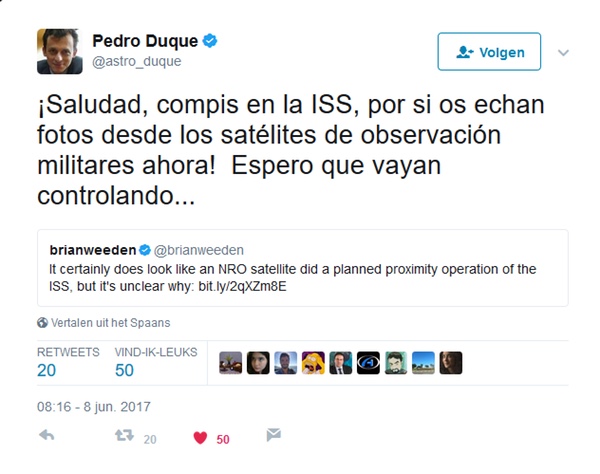 |
This is another reason why, if the flyby was not meant to be intentional, letting it happen was negligent: the publicity and questions it raised certainly created public attention to USA 276, compromising the classified character of the mission. What happened near June 3, intentional or not, was therefore really weird.
